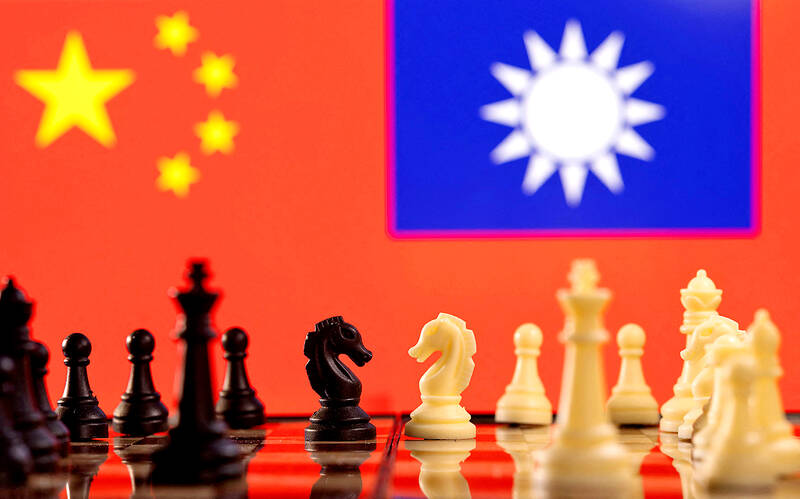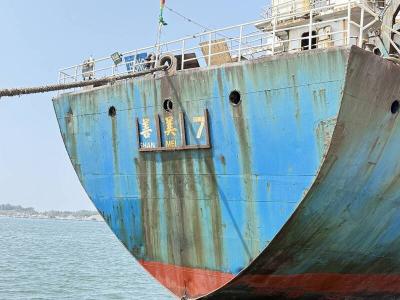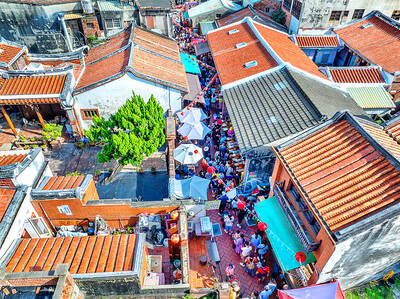The international community should be mindful of China’s “gray zone” activities carried out by its maritime militia and coast guard west of the first island chain, an area where Beijing seeks to establish full control, a former Japanese Navy rear admiral told a security forum in Taipei on Friday.
China has been exploiting freedom of navigation by deploying its maritime militia to international waters to escalate its “gray zone” activities, Katsuya Yamamoto, who was in the Japanese Maritime Self-Defense Force, said at the International Conference on Sea Lane Security held by the Ocean Affairs Council and National Sun Yat-sen University.
“Gray zone” activities refer to actions that fall between the traditional notions of war and peace, typically involving ambiguous or non-traditional methods that aim to achieve strategic objectives without overtly crossing the threshold into open conflict.

Photo: Reuters
Among China’s activities that are considered to meet the definition are the regular crossing of the median line of the Taiwan Strait by Chinese People’s Liberation Army (PLA) aircraft. In the past few months, it has also used its coast guard and maritime militia to intimidate Philippine vessels operating near Second Thomas Shoal (Renai Shoal, 仁愛暗沙) in the Spratly Islands (Nansha Islands, 南沙群島) — which Taiwan also claims — ramming them, and deploying military-grade lasers and water cannons against them.
China has also been preventing fishers from accessing traditional fishing sites within the Philippine exclusive economic zone, negatively affecting local economies, foreign media reported.
China has accused Taiwan’s ruling Democratic Progressive Party of incrementally pushing for independence and insisted that it has the right to patrol the waters around the Spratly Islands.
Yamamoto, who now heads the Security Studies Program at the Tokyo-based Sasakawa Peace Foundation, said that China’s maritime militia is part of the PLA and has taken part in wars, including the 1979 Sino-Vietnamese War.
Under international humanitarian law, the maritime militia is defined as a regular part of the country’s armed forces and a combatant, he said.
China inculcates the notion in its soldiers and sailors that whatever happens in the waters west of the first island chain — the string of islands from the Japanese archipelago, through Taiwan and the Philippines to Borneo, Indonesia — is a “domestic matter.”
Based on that premise, all hostile elements west of the chain must be eliminated — a task that falls to the China Coast Guard, he said.
The China Coast Guard is different from its foreign counterparts, as it functions as a “complete naval force” that can operate independently even if China escalates its “gray zone” activities, he said, adding that the coast guards of Taiwan, Japan and the Philippines would need the support of their respective navies in such a scenario.
If democratic countries ignore the “gray zone” situation that China seeks to perpetuate with its maritime militia, the international order would transform into a “Chinese-style international order” as envisioned by Beijing, Yamamoto said.
It is important that the international community increase the visibility and transparency of what is happening in the waters west of the first island chain, share the intelligence, and jointly condemn and push back against challenges to the “status quo,” he said.

An undersea cable to Penghu County has been severed, the Ministry of Digital Affairs said today, with a Chinese-funded ship suspected of being responsible. It comes just a month after a Chinese ship was suspected of severing an undersea cable north of Keelung Harbor. The National Communications and Cyber Security Center received a report at 3:03am today from Chunghwa Telecom that the No. 3 cable from Taiwan to Penghu was severed 14.7km off the coast of Tainan, the Ministry of Digital Affairs said. The Coast Guard Administration (CGA) upon receiving a report from Chunghwa Telecom began to monitor the Togolese-flagged Hong Tai (宏泰)

A cat named Mikan (蜜柑) has brought in revenue of more than NT$10 million (US$305,390) for the Kaohsiung MRT last year. Mikan, born on April 4, 2020, was a stray cat before being adopted by personnel of Kaohsiung MRT’s Ciaotou Sugar Refinery Station. Mikan was named after a Japanese term for mandarin orange due to his color and because he looks like an orange when curled up. He was named “station master” of Ciaotou Sugar Refinery Station in September 2020, and has since become famous. With Kaohsiung MRT’s branding, along with the release of a set of cultural and creative products, station master Mikan

RISING TOURISM: A survey showed that tourist visits increased by 35 percent last year, while newly created attractions contributed almost half of the growth Changhua County’s Lukang Old Street (鹿港老街) and its surrounding historical area clinched first place among Taiwan’s most successful tourist attractions last year, while no location in eastern Taiwan achieved a spot in the top 20 list, the Tourism Administration said. The listing was created by the Tourism Administration’s Forward-looking Tourism Policy Research office. Last year, the Lukang Old Street and its surrounding area had 17.3 million visitors, more than the 16 million visitors for the Wenhua Road Night Market (文化路夜市) in Chiayi City and 14.5 million visitors at Tainan’s Anping (安平) historical area, it said. The Taipei 101 skyscraper and its environs —

Taiwan on Friday said a New Zealand hamburger restaurant has apologized for a racist remark to a Taiwanese customer after reports that it had first apologized to China sparked outrage in Taiwan. An image posted on Threads by a Taiwanese who ate at Fergburger in Queenstown showed that their receipt dated Sunday last week included the words “Ching Chang,” a racial slur. The Chinese Consulate-General in Christchurch in a statement on Thursday said it had received and accepted an apology from the restaurant over the incident. The comment triggered an online furor among Taiwanese who saw it as an insult to the